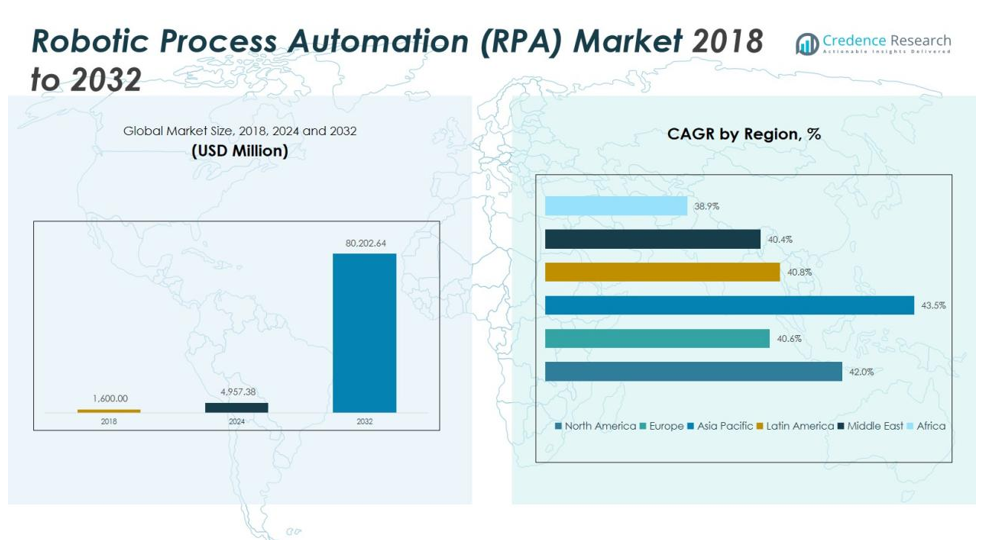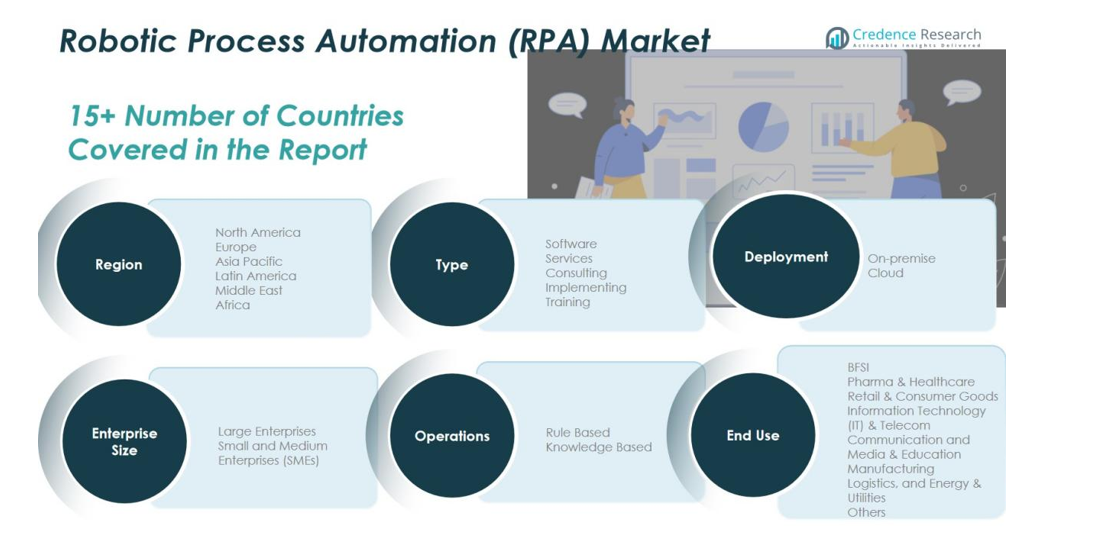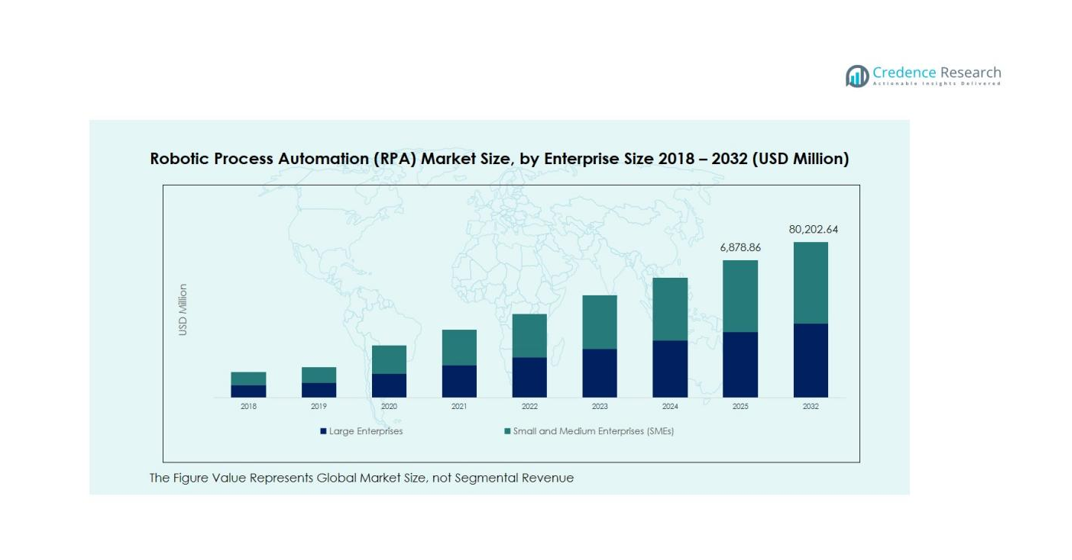CHAPTER NO. 1 : GENESIS OF THE MARKET
1.1 Market Prelude – Introduction & Scope
1.2 The Big Picture – Objectives & Vision
1.3 Strategic Edge – Unique Value Proposition
1.4 Stakeholder Compass – Key Beneficiaries
CHAPTER NO. 2 : EXECUTIVE LENS
2.1 Pulse of the Industry – Market Snapshot
2.2 Growth Arc – Revenue Projections (USD Million)
2.3. Premium Insights – Based on Primary Interviews
CHAPTER NO. 3 : ROBOTIC PROCESS AUTOMATION (RPA) MARKET FORCES & INDUSTRY PULSE
3.1 Foundations of Change – Market Overview
3.2 Catalysts of Expansion – Key Market Drivers
3.2.1 Momentum Boosters – Growth Triggers
3.2.2 Innovation Fuel – Disruptive Technologies
3.3 Headwinds & Crosswinds – Market Restraints
3.3.1 Regulatory Tides – Compliance Challenges
3.3.2 Economic Frictions – Inflationary Pressures
3.4 Untapped Horizons – Growth Potential & Opportunities
3.5 Strategic Navigation – Industry Frameworks
3.5.1 Market Equilibrium – Porter’s Five Forces
3.5.2 Ecosystem Dynamics – Value Chain Analysis
3.5.3 Macro Forces – PESTEL Breakdown
3.6 Price Trend Analysis
3.6.1 Regional Price Trend
3.6.2 Price Trend by product
CHAPTER NO. 4 : KEY INVESTMENT EPICENTER
4.1 Regional Goldmines – High-Growth Geographies
4.2 Product Frontiers – Lucrative Product Categories
4.3 Deployment Sweet Spots – Emerging Demand Segments
CHAPTER NO. 5: REVENUE TRAJECTORY & WEALTH MAPPING
5.1 Momentum Metrics – Forecast & Growth Curves
5.2 Regional Revenue Footprint – Market Share Insights
5.3 Segmental Wealth Flow – Type & Deployment Revenue
CHAPTER NO. 6 : TRADE & COMMERCE ANALYSIS
6.1. Import Analysis by Region
6.1.1. Global Robotic Process Automation (RPA) Market Import Revenue By Region
6.2. Export Analysis by Region
6.2.1. Global Robotic Process Automation (RPA) Market Export Revenue By Region
CHAPTER NO. 7 : COMPETITION ANALYSIS
7.1. Company Market Share Analysis
7.1.1. Global Robotic Process Automation (RPA) Market: Company Market Share
7.2. Global Robotic Process Automation (RPA) Market Company Revenue Market Share
7.3. Strategic Developments
7.3.1. Acquisitions & Mergers
7.3.2. New Product Launch
7.3.3. Regional Expansion
7.4. Competitive Dashboard
7.5. Company Assessment Metrics, 2024
CHAPTER NO. 8 : ROBOTIC PROCESS AUTOMATION (RPA) MARKET – BY TYPE SEGMENT ANALYSIS
8.1. Robotic Process Automation (RPA) Market Overview by Type Segment
8.1.1. Robotic Process Automation (RPA) Market Revenue Share By Type
8.2. Software
8.3. Services
8.3.1 Consulting
8.3.2 Implementing
8.3.3 Training
CHAPTER NO. 9 : ROBOTIC PROCESS AUTOMATION (RPA) MARKET – BY DEPLOYMENT SEGMENT ANALYSIS
9.1. Robotic Process Automation (RPA) Market Overview by Deployment Segment
9.1.1. Robotic Process Automation (RPA) Market Revenue Share By Deployment
9.2. On-premise
9.3. Cloud
CHAPTER NO. 10 : ROBOTIC PROCESS AUTOMATION (RPA) MARKET – BY END-USE SEGMENT ANALYSIS
10.1. Robotic Process Automation (RPA) Market Overview by End-use Segment
10.1.1. Robotic Process Automation (RPA) Market Revenue Share By End-use
10.2. BFSI
10.3. Pharma & Healthcare
10.4 Retail & Consumer Goods
10.5. Information Operations (IT) & Telecom
10.6. Communication and Media & Education
10.7. Manufacturing
10.8. Logistics, and Energy & Utilities
10.9. Others
CHAPTER NO. 11 : ROBOTIC PROCESS AUTOMATION (RPA) MARKET – BY OPERATIONS SEGMENT ANALYSIS
11.1. Robotic Process Automation (RPA) Market Overview by Operations Segment
11.1.1. Robotic Process Automation (RPA) Market Revenue Share By Operations
11.2. Rule Based
11.3. Knowledge Based
CHAPTER NO. 12 : ROBOTIC PROCESS AUTOMATION (RPA) MARKET – BY ENTERPRISE SIZE SEGMENT ANALYSIS
12.1. Robotic Process Automation (RPA) Market Overview by Enterprise Size Segment
12.1.1. Robotic Process Automation (RPA) Market Revenue Share By Enterprise Size
12.2. Large Enterprises
12.3. Small and Medium Enterprises (SMEs)
CHAPTER NO. 13 : ROBOTIC PROCESS AUTOMATION (RPA) MARKET – REGIONAL ANALYSIS
13.1. Robotic Process Automation (RPA) Market Overview by Region Segment
13.1.1. Global Robotic Process Automation (RPA) Market Revenue Share By Region
13.1.2. Regions
13.1.3. Global Robotic Process Automation (RPA) Market Revenue By Region
13.1.4. Type
13.1.5. Global Robotic Process Automation (RPA) Market Revenue By Type
13.1.6. Deployment
13.1.7. Global Robotic Process Automation (RPA) Market Revenue By Deployment
13.1.8. End-use
13.1.9. Global Robotic Process Automation (RPA) Market Revenue By End-use
13.1.10. Operations
13.1.12. Global Robotic Process Automation (RPA) Market Revenue By Operations
13.1.13. Enterprise Size
13.1.14. Global Robotic Process Automation (RPA) Market Revenue By Enterprise Size
CHAPTER NO. 14 : NORTH AMERICA ROBOTIC PROCESS AUTOMATION (RPA) MARKET – COUNTRY ANALYSIS
14.1. North America Robotic Process Automation (RPA) Market Overview by Country Segment
14.1.1. North America Robotic Process Automation (RPA) Market Revenue Share By Region
14.2. North America
14.2.1. North America Robotic Process Automation (RPA) Market Revenue By Country
14.2.2. Type
14.2.3. North America Robotic Process Automation (RPA) Market Revenue By Type
14.2.4. Deployment
14.2.5. North America Robotic Process Automation (RPA) Market Revenue By Deployment
14.2.6. End-use
14.2.7. North America Robotic Process Automation (RPA) Market Revenue By End-use
14.2.8. Operations
14.2.9. North America Robotic Process Automation (RPA) Market Revenue By Operations
14.2.10. Enterprise Size
14.2.11. North America Robotic Process Automation (RPA) Market Revenue By Enterprise Size
14.3. U.S.
14.4. Canada
14.5. Mexico
CHAPTER NO. 15 : EUROPE ROBOTIC PROCESS AUTOMATION (RPA) MARKET – COUNTRY ANALYSIS
15.1. Europe Robotic Process Automation (RPA) Market Overview by Country Segment
15.1.1. Europe Robotic Process Automation (RPA) Market Revenue Share By Region
15.2. Europe
15.2.1. Europe Robotic Process Automation (RPA) Market Revenue By Country
15.2.2. Type
15.2.3. Europe Robotic Process Automation (RPA) Market Revenue By Type
15.2.4. Deployment
15.2.5. Europe Robotic Process Automation (RPA) Market Revenue By Deployment
15.2.6. End-use
15.2.7. Europe Robotic Process Automation (RPA) Market Revenue By End-use
15.2.8. Operations
15.2.9. Europe Robotic Process Automation (RPA) Market Revenue By Operations
15.2.10. Enterprise Size
15.2.11. Europe Robotic Process Automation (RPA) Market Revenue By Enterprise Size
15.3. UK
15.4. France
15.5. Germany
15.6. Italy
15.7. Spain
15.8. Russia
15.9. Rest of Europe
CHAPTER NO. 16 : ASIA PACIFIC ROBOTIC PROCESS AUTOMATION (RPA) MARKET – COUNTRY ANALYSIS
16.1. Asia Pacific Robotic Process Automation (RPA) Market Overview by Country Segment
16.1.1. Asia Pacific Robotic Process Automation (RPA) Market Revenue Share By Region
16.2. Asia Pacific
16.2.1. Asia Pacific Robotic Process Automation (RPA) Market Revenue By Country
16.2.2. Type
16.2.3. Asia Pacific Robotic Process Automation (RPA) Market Revenue By Type
16.2.4. Deployment
16.2.5. Asia Pacific Robotic Process Automation (RPA) Market Revenue By Deployment
16.2.6. End-use
16.2.7. Asia Pacific Robotic Process Automation (RPA) Market Revenue By End-use
16.2.8. Operations
16.2.9. Asia Pacific Robotic Process Automation (RPA) Market Revenue By Operations
16.2.10. Enterprise Size
16.2.11. Asia Pacific Robotic Process Automation (RPA) Market Revenue By Enterprise Size
16.3. China
16.4. Japan
16.5. South Korea
16.6. India
16.7. Australia
16.8. Southeast Asia
16.9. Rest of Asia Pacific
CHAPTER NO. 17 : LATIN AMERICA ROBOTIC PROCESS AUTOMATION (RPA) MARKET – COUNTRY ANALYSIS
17.1. Latin America Robotic Process Automation (RPA) Market Overview by Country Segment
17.1.1. Latin America Robotic Process Automation (RPA) Market Revenue Share By Region
17.2. Latin America
17.2.1. Latin America Robotic Process Automation (RPA) Market Revenue By Country
17.2.2. Type
17.2.3. Latin America Robotic Process Automation (RPA) Market Revenue By Type
17.2.4. Deployment
17.2.5. Latin America Robotic Process Automation (RPA) Market Revenue By Deployment
17.2.6. End-use
17.2.7. Latin America Robotic Process Automation (RPA) Market Revenue By End-use
17.2.8. Operations
17.2.9. Latin America Robotic Process Automation (RPA) Market Revenue By Operations
17.2.10. Enterprise Size
17.2.11. Latin America Robotic Process Automation (RPA) Market Revenue By Enterprise Size
17.3. Brazil
17.4. Argentina
17.5. Rest of Latin America
CHAPTER NO. 18 : MIDDLE EAST ROBOTIC PROCESS AUTOMATION (RPA) MARKET – COUNTRY ANALYSIS
18.1. Middle East Robotic Process Automation (RPA) Market Overview by Country Segment
18.1.1. Middle East Robotic Process Automation (RPA) Market Revenue Share By Region
18.2. Middle East
18.2.1. Middle East Robotic Process Automation (RPA) Market Revenue By Country
18.2.2. Type
18.2.3. Middle East Robotic Process Automation (RPA) Market Revenue By Type
18.2.4. Deployment
18.2.5. Middle East Robotic Process Automation (RPA) Market Revenue By Deployment
18.2.6. End-use
18.2.7. Middle East Robotic Process Automation (RPA) Market Revenue By End-use
18.2.8. Operations
18.2.9. Middle East Robotic Process Automation (RPA) Market Revenue By Operations
18.2.10. Enterprise Size
18.2.11. Middle East Robotic Process Automation (RPA) Market Revenue By Enterprise Size
18.3. GCC Countries
18.4. Israel
18.5. Turkey
18.6. Rest of Middle East
CHAPTER NO. 19 : AFRICA ROBOTIC PROCESS AUTOMATION (RPA) MARKET – COUNTRY ANALYSIS
19.1. Africa Robotic Process Automation (RPA) Market Overview by Country Segment
19.1.1. Africa Robotic Process Automation (RPA) Market Revenue Share By Region
19.2. Africa
19.2.1. Africa Robotic Process Automation (RPA) Market Revenue By Country
19.2.2. Type
19.2.3. Africa Robotic Process Automation (RPA) Market Revenue By Type
19.2.4. Deployment
19.2.5. Africa Robotic Process Automation (RPA) Market Revenue By Deployment
19.2.6. End-use
19.2.7. Africa Robotic Process Automation (RPA) Market Revenue By End-use
19.2.8. Operations
19.2.9. Africa Robotic Process Automation (RPA) Market Revenue By Operations
19.2.10. Enterprise Size
19.2.11. Africa Robotic Process Automation (RPA) Market Revenue By Enterprise Size
19.3. South Africa
19.4. Egypt
19.5. Rest of Africa
CHAPTER NO. 20 : COMPANY PROFILES
20.1. Automation Anywhere Inc.
20.1.1. Company Overview
20.1.2. Product Portfolio
20.1.3. Financial Overview
20.1.4. Recent Developments
20.1.5. Growth Strategy
20.1.6. SWOT Analysis
20.2. BlackLine Inc.
20.3. Blue Prism Limited
20.4. EdgeVerve Systems Limited
20.5. FPT Software
20.6. Microsoft
20.7. OnviSource, Inc.
20.8. Pegasystems Inc.
20.9. SAP SE
20.10. Tungsten Automation Corporation










